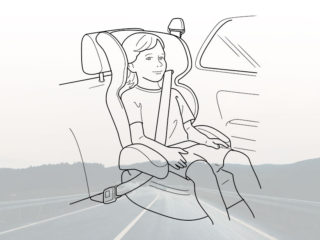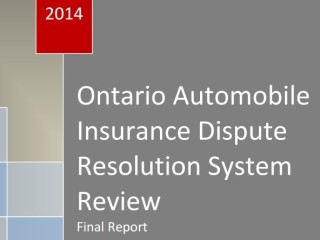Full Decision
(Tulloch, Roberts and Miller JJ.A.)
Appeal from Trial Decision (Jury) Regarding Findings of Contributory Negligence
MATERIAL FACTS
This is an Appeal from the judgment of Quinlan J., sitting with a jury, dated May 23, 2018. The Appellant, the trial Defendant Floyd Sinton Limited, was found 75% liable for the damages incurred by the Plaintiff/Respondent, Sarah Little. On the final day of Grade 8, Ms. Little jumped from the rear door of a moving school bus operated by the Appellant, suffering catastrophic head trauma. Ms. Little was found 25% contributorily negligent. Ms. Little was awarded 7,032,600 + PJI and costs at trial.
Of note, the Appellant argues that the trial judge erred in her instructions on causation and the jury erred when making findings of fact on causation and contributory negligence. Further that the trial judge erred with respect to the question of mitigation and reduction of the Plaintiff’s damages. This case also dealt with s. 267.8(4)(8) of the insurance Act, which was remitted back to trial for a hearing and will not be discussed.
ISSUES
i. Whether, in her charge to the jury, the trial judge misstated the law of negligence and causation? (the jury’s verdict therefore unreasonable and should not stand);
ii. Whether, in her charge to the jury, the trial judge erroneously instructed the jury that as a matter of law they could not reduce Ms. Little’s damages for a failure to mitigate by not implementing specific treatment recommendations.
BRIEF ANSWER
Appeal Dismissed, with respect to the issue of the trial Judge’s charge to the Jury, the findings of contributory negligence/ causation, and mitigation.
ANALYSIS
Roberts J.A., writing for the Court of Appeal rejected the Appellants argument at [17] going on to note that the jury charge must be considered against the entire charge and the trial as a whole, citing Surujdeo v. Melady, 2017 ONCA 41; R. v. Daley, 2007 SCC 53. ‘the question on appellate review is whether the charge provided the jury with adequate assistance to determine the questions it had to decide’ citing Samms v. Moola, 2019 ONCA 220.
The Trial judge clearly set out at [19]:
‘the factors that led to Ms. Little’s decision to jump from a moving school bus. In the context of summarizing the parties’ respective positions, the trial judge explained how these factors related to the parties’ negligence theories. She correctly explained the difference between the issues of causation and apportionment of liability. She reviewed the “but for” test for causation.’
Of note, trial counsel drafted this component of the charge and no objection was taken to it. Roberts J.A., concluded at [20] that ‘there was no question that the jury was alive to the defence position that Ms. Little should be principally responsible for her decision to jump from a moving school bus.’ This was reflected in the finding that she was 25% contributory negligent.
The standard of appellate review of a civil jury trial is exceptionally high. Citing Stilwell v. world Kitchen Inc., 2014 ONCA 770 at [33]: Roberts J.A., noted that a jury’s verdict should only be set aside ‘where it is so plainly unreasonable and unjust that no jury reviewing the evidence as a whole and acting judicially could have arrived at the verdict’.
With respect to the issue of Mitigation, the trial judge’s charge read as follows:
‘I have decided as a matter of law that you cannot make any reduction to Ms. Little’s damages for failure to mitigate. You cannot hold Ms. Little responsible for any failures on the part of her mother or treatment providers to implement treatment recommendations. As for Ms. Little, she was an adolescent and then a young adult diagnosed with a brain injury who, upon attaining adulthood, was assessed to be incapable of managing her personal care and her property. Accordingly, Ms. Little cannot be held responsible for her decisions as she was not capable of making decisions concerning her treatment.
In any event, there is no evidence to prove that Ms. Little’s damages would have been reduced had she obtained the recommended treatment. [emphasis added]’
Roberts J.A. at [27] concluded that while the trial judge erred in removing the question of mitigation form the jury, the error occasioned no miscarriage of justice since it would not have affected the trial outcome. There was no medical expert evidence that Ms. Little’s prognosis would have differed or that her damages be reduced. Importantly, there was no specific expert medical evidence that treatment would have somehow been able to allow her to live independently and become financially self-sufficient. Ksiazek v. Newport Leasing Ltd., (2006), 43 C.C.L.I. (4th) 238 (Ont. S.C.) aff’d 2010 ONCA 341.
Even if such evidence was present, which it was not, the onus is on the Defendant/Appellant to establish (1) that the Plaintiff acted unreasonably in not following the recommended treatment; (2) the extent, if any, to which the Plaintiff’s damages would have been reduced had he or she acted reasonably. The Defendant/Appellant must have pointed to the necessary evidence ‘to raise failure to mitigate from speculation to reasonable inference’ Chiu v. Chiu, 2002 BCCA 618 B.C.L.R. (4th) 227. The onus is one of a balance of probabilities: Janiak v. Ippolito, [1985] 1 S.C.R. 146.
CONCLUSION
Roberts J.A, was satisfied at [52] that no miscarriage of justice occurred from the trial judge’s error in failing to put the mitigation issue to the jury under the circumstances. Moreover, the standard has not been met with respect to the alleged misdirection on causation and negligence. There was ample evidence to support the jury’s verdict and apportionment of liability.














